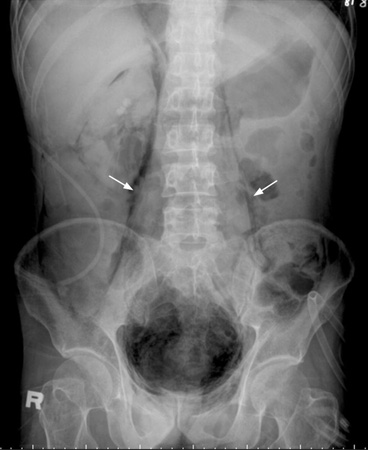Complications
Men, older women, and patients with diabetes or neurogenic bladders may require urethral catheterization to improve urine outflow. Rarely, blood clots may be severe enough to require bladder irrigation.
May be the result of a severe complicated infection, related to antibiotic treatment, or associated with multiorgan failure from sepsis. Medication doses may need to be adjusted. Nephrotoxic agents should be avoided.
The infecting organisms may be, or become, resistant to antibiotics. Secondary bacterial infections may occur.
Internal foreign bodies (e.g., renal stones, intravenous catheters, artificial valves) may prevent clearance of bacteria. The first step is to determine the cause of antibiotic failure. Repeat urine and blood cultures are indicated for bacterial or fungal infection and drug sensitivities.
Any indwelling lines should be removed or changed. Imaging as needed is indicated to diagnose potential infected fluid collections or foreign bodies.
Surgical or interventional radiology consultation may be required.
May occur at any time. The most common symptoms are generalized pruritus and rash or hives. Rarely, severe hypersensitivity reactions, including anaphylaxis, can occur.
For mild reactions, further treatment may not be needed, or antihistamines can be prescribed for itching.
More serious reactions may require corticosteroids, epinephrine, and hemodynamic and respiratory support.
A combination of host and organism factors may be causes.
Host factors include multiple medical problems, indwelling catheters, and/or malnutrition.
Organism factors include virulence factors and previous antibiotic treatments.
Sepsis generally requires monitoring in an intensive care unit. Important steps include removal of precipitating factors (e.g., infected intravenous lines), maintenance of hemodynamic and nutritional parameters, and appropriate antibiotic treatment.[85][86]
A result of tissue destruction from both bacterial and host factors.
Appropriate imaging studies (such as ultrasound or CT) are indicated to localize the abscess. Surgical drainage or drainage by interventional radiologist is required.
Emphysematous pyelonephritis (EPN) is a severe necrotizing infection of the renal parenchyma; it causes gas formation within the collecting system, renal parenchyma, and/or perirenal tissues.[Figure caption and citation for the preceding image starts]: Psoas muscle shadow enhanced by retroperitoneal air in emphysematous pyelonephritisCourtesy of Shih-Hung Tsai and Shi-Jye Chu, Department of Emergency Medicine, Tri-Service General Hospital, National Defense Medical Center, Taiwan, Republic of China [Citation ends].
Gas in the renal pelvis alone, without parenchymal gas, is often referred to as emphysematous pyelitis. EPN is common in persons with diabetes, and the presentation of EPN is similar to that of acute pyelonephritis. However, the clinical course of EPN can be severe and life-threatening if not recognized and treated promptly.
Occurs in complicated infections. May occur at sites of infectious foci in patients unresponsive to antibiotic therapy or who have underlying urogenital abnormalities that predispose to recurrent infections. Prevention of progressive renal damage is of primary importance.
Treatment of underlying diseases and modifying risk factors are the main interventions.
Once permanent renal damage has occurred, no treatment is available.
Depends on a number of factors, including local resistance patterns, number of recurrent infections, antibiotics used, and compliance with therapy. May result from colonization with uropathogenic or resistant bacteria.
Repeat cultures should be obtained to ascertain etiology and antibiotic susceptibility.
Use of this content is subject to our disclaimer